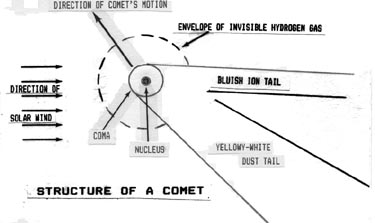THE STRUCTURE OF COMETS
By Tracy Hansen
No one has yet been able to examine a comet closely.* Our knowledge of the structure of comets has relied on theories derived from photographic records, observations of the behavior of comets, and analyses of the light they emit.
The most widely accepted theory at the present time is that comets are best described as “dirty snowballs”, consisting of about 50% dust particles, 40% water ice and 10% other materials. This description is of the NUCLEUS of a comet. Nuclei are small. The nucleus of Halley’s comet is thought to be about 5 km (3 miles) in diameter.

No one has yet been able to observe the nucleus of any comet because it is always hidden from sight by the COMA, a large envelope of gas that develops as the comet approaches the Sun.* Typically, the coma starts to develop when the comet crosses the orbit of Jupiter. The heat of the Sun causes some of the ice in the nucleus to evaporate, forming a haze of gas and dust particles around the solid nucleus. The comas of comets may range in size from about 100,000 km in diameter to as much as a million km. The coma of a typical comet is usually about 200,000 km in diameter – about half the distance between Earth and the Moon. Around the coma, a further ENVELOPE OF INVISIBLE HYDROGEN GAS may extend out many millions of kilometers further.
A tail begins to form as the comet gets closer to the Sun, usually when it is about as far from the Sun as the distance of the Earth’s orbit. The coma is affected by solar winds and by radiation produced by the Sun. The solar wind, a constant stream of particles (mainly protons and electrons), ionizes atoms in the coma and blows them away from the nucleus in a narrow, BLUISH ION TAIL. Also, the pressure of the Sun’s radiation (visible light, and radiation in other wavelengths) pushes dust particles in the coma away from the nucleus to form a YELLOW-WHITE TAIL, which tends to curve in the direction of the comet’s motion. Because the Sun is, in effect, blowing matter away from the nucleus to form the tail, the tail is always directed away from the Sun.
Thus, every time a comet returns, it loses some of the material in its nucleus. When Halley’s comet returns in 1985-86 it will be a little smaller than it was on its passage of 1910. This is one of the reasons why it is not expected to be as bright on this return.
* Editor’s
note: This article was written two years before the Halley space probes
were actually able to examine Halley’s Comet closely and actually observed the
nucleus of the comet.
Return to Halley's Comet Watch Newsletter